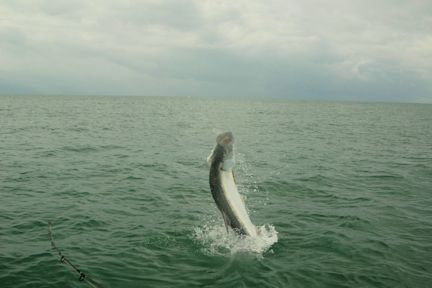FRANK SARGEANT fsargean@tampabay.rr.com
Published: Jun 26, 2003
It’s not over until it’s over. And along Florida’s west coast, the tarpon season is definitely not over, despite the fact most tarpon chasers consider the end of June to be the end of the season for silver kings. Tarpon do become more scarce in the traditional locations – along the beaches, in the large passes and on the deep flats of famed venues such as Homosassa, where sight-fishing has made the pursuit famous. However, for those who don’t insist on seeing their fish before they catch it, tarpon offer plenty of action through mid-October. Biologists say the fish that swarm the beaches and the passes in spring head offshore to spawn around the new and full moons in June. The fish are thought to travel to the edge of the continental shelf, 100 miles out, to drop their eggs in the open sea. But then they return rapidly shoreward, and this time they keep right on going when they hit the passes, traveling far up into blackwater bays where salinity drops to near zero after the heavy summer rains. One Bay area angler who specializes in chasing these fish is captain Chet Jennings of Balm, who says late summer is his favorite time of year. “It’s not uncommon for us to hook four or five fish in a morning,” Jennings said. “That’s better than most people ever do out on the beach in May.” Jennings has several hard bottom areas around Tampa Bay where he knows the fish will gather each summer. But he says anyone can find their own tarpon hot spots by getting out early on calm mornings. “The calmer the water, the more the fish roll,” Jennings said. “On a calm morning, you can see them a quarter-mile, and once you find one pod you’ll probably see a lot of others in that same area, especially if there are a lot of threadfins around.” Jennings says the threadfins, a flat-sided baitfish, also make themselves obvious by feeding at the surface. And they make excellent bait, as well as good chum for turning the fish on. He catches them with a heavily weighted castnet, but said a sabiki rig will do the job for casual anglers. Jennings recommend fishing threads on 30-pound-test microfiber line on a heavy spin outfit. The leader is four feet of 100-pound-test clear monofilament, tipped with a 6/0 Owner triple-strong circle hook. “With the circle hooks, you just let the fish eat the bait and start reeling,” Jennings said. “You don’t have to set the hook, which is where most tarpon are lost with conventional J hooks.” He said he finds most of his fish in depths of six to 12 feet. “You can tell you’re over hard bottom because you’ll snag on bits of coral and sea fans,” Jennings said. Captain Mike Talkington of Plant City also finds plenty of late summer fish in Tampa Bay, using a combination of live bait and soft plastic mullet such as the DOA, as well as imitation shrimp and crabs. “With the lures, the trick is to get the cast on the fish the minute they roll,” Talkington said. “Let it sink down in front of them, and a lot of times they’ll eat it before you even start to retrieve.” Some anglers even connect by tossing noisy topwater plugs over the fish. The strikes tend to be spectacular, though the ratio of solid hookups is low. Some of the better summer areas include the outer edges of the flats at Weedon Island and Apollo Beach, Long Bar and the west side of Davis Island in Hillsborough Bay, hard bottom at Rattlesnake Key, south and west of the Skyway, and the waters south of Rocky Point in Old Tampa Bay. The fish also invade completely fresh water in area rivers. The Palm, Alafia, Little Manatee and Manatee hold summer tarpon, as do the lower stretches of the Peace and the Myakka, which feed Charlotte Harbor. It’s rare to catch very heavy fish in late summer, in part because the big females already have dropped lots of weight because of spawning, but fish of 100 to 120 pounds are common. Some tarpon typically remain inshore until the first cool weather arrives in mid- to late October. Most then appear to migrate offshore or southward to the Keys, to start their return again the following spring.
- Jay Mastry - March 26, 2024
- Captains Corner, Gorta - March 23, 2024
- Dave Zalewski - March 12, 2024











